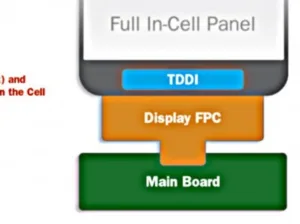The latest integrated touch technologies were shown at the Touch Taiwan 2016 conference that took place in Taipei during late August. Of particular interest, liquid crystal display panel manufacturers showed devices with in-cell touch capability based on Touch with Display Driver Integration (TDDI) technology. Devices of this type included a single IC to integrate display control with touch control.
First, a little background information. There are various implementations of touch technology. The discussion below is drawn from the approach implemented by Synaptics.
Integrating touch and display functions in a single display device consists of two related but separate challenges. The first is including a touch sensing means into the display panel stack-up. The second is the development of IC means to control both touch and display functions.
In the past, touch sensors were typically added as a separate overlay atop the display in a laminated panel stack-up. This well-established approach is cost effective and dependable.
More recently, technological advances have made it possible to integrate touch sensors directly into one or more layers within the display stack-up. This integration can occur on top of the display cell and is called on-cell integration. It is illustrated in the left hand portion of the figure below. Alternately, the integration can occur within the display cell. This is called in-cell integration and illustrated in the central figure below.
In conjunction with in-cell touch integration, Synaptics touch and display driver integration allows the use of just a single, flexible, printed circuit connector. This configuration is illustrated in the right hand portion of the figure below.

Synaptics claims that the company’s in-cell touch panel approach based on TDDI technology has a variety of advantages including the following:
- Minimizes the incorrect identification of touch events.
- Thinner form factors and narrower bezels enable improved industrial design.
- Brighter displays due to fewer layers in the touchscreen. Alternatively, the result can be a longer battery life for a device having the same brightness.
- Lower system cost due to a reduced number of components, the elimination of lamination steps and an increase in manufacturing yield.
- Simplifies the supply chain by allowing sourcing of both the touch panel and the LCD from one manufacturer.
A video that presents a discussion about the synaptic integrated touch panel display can be found at the end of this article.
At the Touch Taiwan 2016 conference, LCD panel makers AU Optronics, Innolux and Chunghwa Picture Tubes showcased TDDI technology-based in-cell touch panels. In each case, the capability was “developed in cooperation with Taiwan-based IC design houses FocalTech Systems, Novatek Microelectronics and Raydium Semiconductor as well as US-based Synaptics. In addition, Taiwan-based IC design house Himax Technologies exhibited such touch panels through cooperation with LG Display.”
It might be noted that Innolux and Chunghwa Picture Tubes “have applied TDDI technology-based in-cell to a-Si TFT-LCD panels, with such touch panels specifically for use in entry-level and mid-range smartphones.” -Arthur Berman
http://players.brightcove.net/4709052657001/default_default/index.html?videoId=4710089006001

